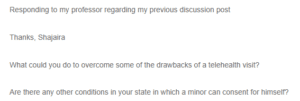Faculty Response Post- Telehealth Visit
How to Overcome Some of the Drawbacks of Telehealth Visit
Telehealth visits are sometimes faced with considerable drawbacks. However, several interventions can be used to address these drawbacks. The first intervention is to expand the caregivers’ and patient’s capacity to utilize diverse telehealth devices. This can be attained by a systematic educative approach that teaches them how to handle these devices. Making these telehealth devices available to all patients may also be key in enhancing telehealth visits, as some of these devices tend to be expensive and out of reach for some patients. The integration of video-capturing devices can also assist caregivers in conducting physical examinations of their clients.
Consent
Florida’s Department of Children and Families (DCF) statutes detail provisions for informed consent. Per these statutes, minors cannot seek therapy without parental consent. However, minors aged 13 and above preserve the right to consent to, request, or receive outpatient crisis intervention if they experience an emotional crisis they perceive requires professional assistance. The outpatient crisis interventions provided for in this statute include group therapy, psychotherapy, and counseling, among other mental healthcare services.
Assessing Social Determinants of Health Status
Various tools can be used to assess the social determinants of health status. The Area Deprivation Index (ADI) is a validated tool that details employment, income, housing quality, and education status. The scores obtained from this tool demonstrate the socioeconomic advantage or disadvantage apparent in some communities. It also gives insight into areas that can be addressed to improve the overall wellness of various neighborhoods.
No-Suicide/Harm Contracts
The no-suicide contract is a common intervention used in managing suicidality. Notwithstanding, there is a contrary belief that no suicide contracts are not the best practice in mental healthcare (Rozek et al., 2022). Contraindicated interventions often convey, undoubtedly, the risk benefits status of an intervention. However, they are often influenced by a weak evidence base and can be disputed.
References
Rozek, D. C., Tyler, H., Fina, B. A., Baker, S. N., Moring, J. C., Smith, N. B., Baker, J. C., Bryan, A. O., Bryan, C. J., & Dondanville, K. A. (2022). Suicide intervention practices: What is being used by mental health clinicians and mental health allies? Archives of Suicide Research, 27(3), 1034–1046. https://doi.org/10.1080/13811118.2022.2106923
ORDER A PLAGIARISM-FREE PAPER HERE
We’ll write everything from scratch
Question
Responding to my professor regarding my previous discussion post
Thanks, Shajaira
What could you do to overcome some of the drawbacks of a telehealth visit?

Faculty Response Post- Telehealth Visit
Are there any other conditions in your state in which a minor can consent for himself?
Is there a specific tool that you would use to assess social determinants of health status?
Are no-suicide/harm contracts considered to be a good practice as part of a safety plan?

